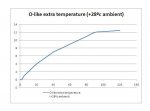- Joined
- Aug 7, 2010
- Messages
- 2,086
- Points
- 0
The tests were made with 140 diodes, both running at 4.2v 600mA.
case temperature when off
(both): 28ºc (ambient)
case temperature when on (aixiz) after 15 seconds: 40ºc and going up
case temperature when on (o-like) after 90 seconds: 40ºc apparently stopped heating
time to reach ambient case temperature after tests
aixiz: 45 sec to 31ºc, 70 sec to 28ºc
o-like: 50 sec to 31ºc, 90 sec to 28ºc
heat dissipation
aixiz: 2 to 3 seconds to transfer heat from one side to the other side of the module (tested with hand touch)
o-like: instant
Mass Quantity (someone could contribute with this info, if possible)
Aixiz material: electroplated brass (nickel/zinc finish). Thanks LazyBeam!
(Unknown mass)
O-like material: Anodized aluminium.
(Unknown mass, but at least 2x than aixiz)
The aixiz module cannot handle more than, lets say, 500mW of heat generated. The o-like was handling 2W pretty well and, I think that in a cold winter it could handle these 2W continuous.
I'm sorry, but I don't have a LPM to test the actual power input - light output to calculate the heat but, it is really around 2W (2,52W in, ~500mW out ~2W heat).
edit: inserted graphics for o-like and aixiz. I drawed it as I feeled they perform, not real temperatures mid-graphic. Only the first and the last numbers are real, the others are how the module perform (aixiz = logarithmic curve, o-like = near linear curve). The numbers are how much temp. the modules gained, above 28ºc (for example, aixiz is 12 at 15 seconds, 28ºc + 12ºc = 40ºc). All temperature is expressed at Degree Celsius escale (metric).
[These tests are part of my diode temperature controller project, that I'll share with LPF when it is ready (if it goes ready )]
)]
edit: sorry for the "-2" temp. at the o-like graphic.
case temperature when off
(both): 28ºc (ambient)
case temperature when on (aixiz) after 15 seconds: 40ºc and going up
case temperature when on (o-like) after 90 seconds: 40ºc apparently stopped heating
time to reach ambient case temperature after tests
aixiz: 45 sec to 31ºc, 70 sec to 28ºc
o-like: 50 sec to 31ºc, 90 sec to 28ºc
heat dissipation
aixiz: 2 to 3 seconds to transfer heat from one side to the other side of the module (tested with hand touch)
o-like: instant
Mass Quantity (someone could contribute with this info, if possible)
Aixiz material: electroplated brass (nickel/zinc finish). Thanks LazyBeam!
(Unknown mass)
O-like material: Anodized aluminium.
(Unknown mass, but at least 2x than aixiz)
The aixiz module cannot handle more than, lets say, 500mW of heat generated. The o-like was handling 2W pretty well and, I think that in a cold winter it could handle these 2W continuous.
I'm sorry, but I don't have a LPM to test the actual power input - light output to calculate the heat but, it is really around 2W (2,52W in, ~500mW out ~2W heat).
edit: inserted graphics for o-like and aixiz. I drawed it as I feeled they perform, not real temperatures mid-graphic. Only the first and the last numbers are real, the others are how the module perform (aixiz = logarithmic curve, o-like = near linear curve). The numbers are how much temp. the modules gained, above 28ºc (for example, aixiz is 12 at 15 seconds, 28ºc + 12ºc = 40ºc). All temperature is expressed at Degree Celsius escale (metric).
[These tests are part of my diode temperature controller project, that I'll share with LPF when it is ready (if it goes ready
edit: sorry for the "-2" temp. at the o-like graphic.
Attachments
Last edited:








